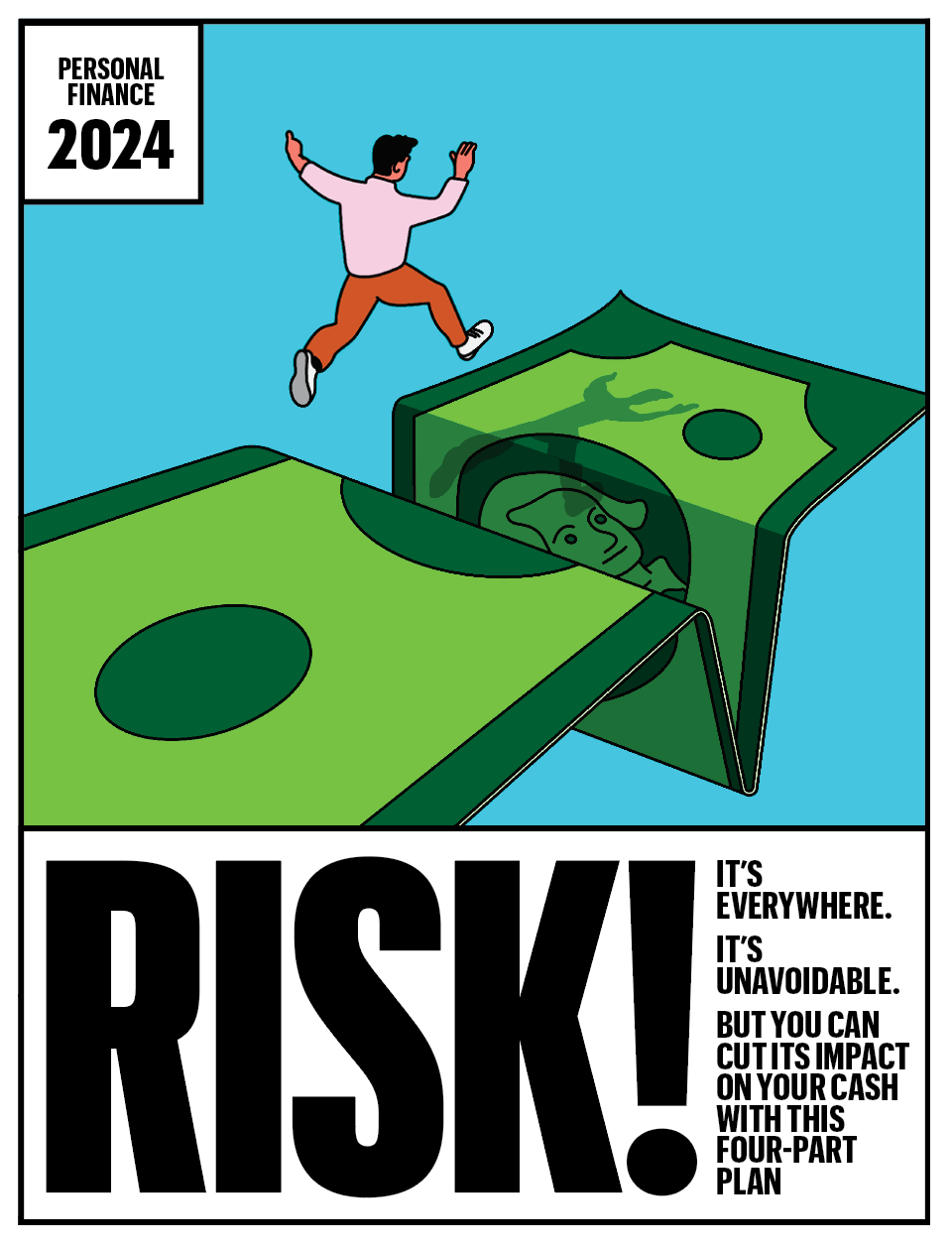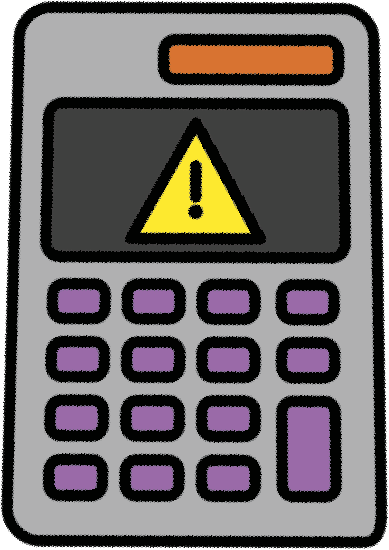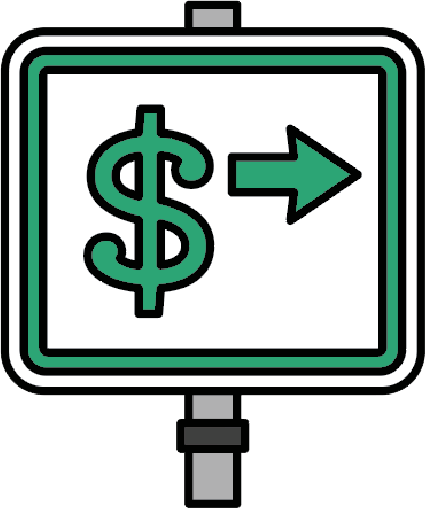FEATURE STORY

PART 1: SAVINGS RISK
Investing for the Nervous Investor
Three tactics for securing your long-term savings and sleeping better at night

WANT ABSOLUTE, nearly 100 percent protection for your retirement money? Secretly install an immovable, indestructible safe in a dark corner of your home and put the cash in there.
That poses some dangers, though. There are the temptation issues of having all those bills at hand. But there’s inflation, too, which diminishes that stash’s buying power over time. At current inflation rates, if you were to pull a $100 bill from that safe 20 years from now to go to the store, it would buy you only what you could get with $54 today.
If you don’t want your money to lose value, putting your cash into the stock market gives you your best shot at having your savings grow the fastest. But you’re also exposed to the risk of big losses, which can do long-term damage to your finances if sustained early in retirement.
So with high inflation on the one hand and a potential stock market crash on the other, is there anything you can do to lessen the anxiety that these risks provoke?
I’m here to say yes. In fact, I have three options for you, all designed to protect against both inflation risk and stock market risk. Let’s take a look.
THE SIMPLE STRATEGY
Maximize Your Social Security
Wouldn’t it be nice to own an annuity that (1) is annually adjusted for inflation, (2) is guaranteed to pay you for life, (3) may provide a survivor benefit for your spouse and (4) has high annual increases no matter what the stock market does? Well, you do. It’s called Social Security.
Point number 4—the guaranteed return—is the clincher in this strategy. For each year from age 62 until 70 that you delay claiming Social Security retirement benefits, your monthly payment rises between 7 and 8 percent. (You’re penalized for taking benefits before your full retirement age [FRA] and rewarded for delaying benefits after your FRA, which is 67 if you were born in 1960 or later.)
Here’s a simple example. Sue is turning 62 and can claim Social Security early for an annual benefit of $25,000; that amount would then be the rate on which her payments would be based for the rest of her life. If, however, she waits one year, she’ll receive $26,800 per year. If she waits until 70 to get her maximum benefit, she’ll receive $44,000 a year. Each year after she claims, her benefit will be increased if prices rise, guaranteeing an inflation-adjusted income no matter how long she lives.

Maximizing your Social Security benefit may not sound clever. And I’m well aware that to delay claiming is financially impossible for many people. But I know of no other tactic that can consistently promise 7 to 8 percent annual increases at zero risk, over a span of some eight years, with those payments also increasing with inflation. This is why people are so often advised to put off claiming as long as feasible, up until age 70.
That can mean staying on the job, tapping retirement savings or living off other assets until your 70th birthday. Just take care not to spend down your assets so much that you can’t cover unexpected emergency expenses or large purchases.
Married? This strategy is particularly important for the higher-wage earner, says Mike Piper, author of Social Security Made Simple. “Waiting to file for Social Security is a much better deal than you’ll find anywhere else, in terms of the amount of safe income it generates,” Piper says. For free calculators you can use to help calculate your own set of numbers, go to aarp.org/socialsecurity or opensocialsecurity.com.
HOW NOT TO STAY SAFE
Some investments don’t protect wealth as well as people believe they will.

GOLD
It’s often pitched as a protection against inflation. The gold I bought in 1980, however, hasn’t come close to keeping up with inflation.
CRYPTOCURRENCY
Just ask someone who held their crypto in the ostensibly safe FTX exchange … before $8 billion of the money vaporized.
HIGH YIELDS
Stocks with big dividends, junk bonds and private real estate deals might offer high income, but pose a bigger risk of losing your principal.
THE INTERMEDIATE STRATEGY
Divide Your Retirement Cash
If the prospect of investing in stocks terrifies you, here’s a way you can get some of their returns without the risk of losing money. You split your retirement stash in two, putting one part into the stock market and the rest in an ultrasafe investment that will preserve your cash no matter how badly stocks perform. This strategy lets you relax, since you know you’ll get all or most of your money back if stocks take a dip—which they often do.
STEP 1: MAKE A COMMITMENT.
Decide how much money you want to invest and how long you can comfortably set it aside. Be thoughtful about this, because if you have to access the money early, you’ll give up your protection against losses.
STEP 2: BUY YOUR SAFE INVESTMENT.
Once you’ve decided on the amount you’ll commit, buy a U.S. government bond that will pay you back that amount in the time frame you’ve chosen. Let’s say I’ve decided to invest a total of $10,000 for 10 years. As of late December, 10-year zero-coupon Treasury notes, which you can buy from brokers, are yielding 4.01 percent. (The interest on “zeros,” as they’re known, is reinvested, so their total return is typically higher than that of a T-note.) I plug that information into a tool I use, the Risk Reduction Calculator at depositaccounts.com/tools/reduce-risk.aspx. It tells me I need to put $6,749 of my initial investment into T-notes in order to get back $10,000 in a decade’s time. So I buy $6,749 in zero-coupon T-notes.

STEP 3: INVEST IN THE MARKET …
Put the balance of your initial investment in a low-cost stock fund and forget about it for 10 years. I like investing in low-expense index funds, so I’d put the remaining $3,251 of my $10,000 investment into an all-U.S. stock fund like Fidelity ZERO Total Market Index Fund, Vanguard Total Stock Market ETF or Schwab Total Stock Market Index Fund. The result: If, after a decade, the stock market has gone to zero, I’ll get my $10,000 back. Anything better than that—even if the market posts massive losses—I’d make a profit.
STEP 4: … AND TAKE A LITTLE RISK.
I’m a very cautious investor, but unless aliens invade the Earth, even I don’t think that all U.S. stocks will go to zero in the next decade. A more reasonable worst-case possibility is that the market will lose half its value in a decade—roughly what happened in the Great Depression. So, using numbers pulled from that same calculator, I’d invest $5,093 in a T-note and the rest of my $10,000 in stocks. If the market fell 50 percent and stayed there, I’d still end up with $10,000 between my two investments. And if stocks approached their 9 percent annualized historical returns, I’d have nearly doubled my money. (See “Safer Stock Investing,” below.)
Some fine print: You have to reinvest all dividends from your stock fund, which can be done automatically. If these investments aren’t in a tax-deferred account like a traditional IRA or tax-free Roth account, you’ll likely owe some taxes on them each year, even if you aren’t pulling money from your account.
Certain insurance company annuities can also capture some stock market gains while protecting you against losses. But they come with multiple fees that eat into much of the stocks’ returns. And annuity guarantees often come as future payouts that can be eroded by inflation, rather than as an immediate cash payment.

SAFER STOCK INVESTING
Putting $10,000 in a mix of stocks and T-notes can protect against losses. Here are investment results in different scenarios.*
OVER THE NEXT DECADE, STOCKS ...: Drop 50%
PORTFOLIO VALUE IN 10 YEARS: $10,000
YOUR INVESTMENT’S ANNUAL RETURN: 0.0%
OVER THE NEXT DECADE, STOCKS ...: Drop 25%
PORTFOLIO VALUE IN 10 YEARS: $11,226
YOUR INVESTMENT’S ANNUAL RETURN: 1.16%
OVER THE NEXT DECADE, STOCKS ...:
Go nowhere
PORTFOLIO VALUE IN 10 YEARS: $12,453
YOUR INVESTMENT’S ANNUAL RETURN: 2.22%
OVER THE NEXT DECADE, STOCKS ...:
Grow 4% annually
PORTFOLIO VALUE IN 10 YEARS: $14,810
YOUR INVESTMENT’S ANNUAL RETURN: 4.01%
OVER THE NEXT DECADE, STOCKS ...:
Grow 8% annually
PORTFOLIO VALUE IN 10 YEARS: $18,140
YOUR INVESTMENT’S ANNUAL RETURN: 6.14%
THE ADVANCED STRATEGY
Buy Inflation-Proof Investments
No one knows how bad inflation will be in years ahead. Will it settle back to under the 2.5 percent rate, where it stayed for most of the 2000s and 2010s? Or will it go higher? I have no idea. What I do know is that there’s currently a way to beat inflation without taking on risk. As of late December, you can earn a return that will be 1.7 percentage points annually higher than whatever inflation turns out to be.
The way to do it is to invest in Treasury Inflation-Protected Securities (TIPS). They are issued by the U.S. government, and most make regular interest payments until they mature, at which point investors get their principal back, adjusted for inflation. (See “Ultrasafe Cash From Uncle Sam,” below, for more on buying TIPS and other Treasury securities.) A 10-year TIPS, as I write this, is guaranteed to increase your money’s spending power by 18.4 percent before taxes.

Once you execute this strategy by buying TIPS, you need to have the courage to do nothing with them until they mature. If you sell them before then, you may very well end up with a lower effective yield than what was promised when you purchased them.
Be aware that the federal government will tax you annually on the change in your principal’s value, even though you won’t receive the money until maturity; that’s why you might want to hold TIPS in tax-deferred or tax-free IRAs.
BEATING THE CPI
TIPS maturing in these years yield nearly 2 percentage points over the rate of inflation.
YEAR: 2029
YIELD OVER INFLATION: 1.47%
YEAR: 2033
YIELD OVER INFLATION: 1.73%
YEAR: 2040
YIELD OVER INFLATION: 1.86%
Also, keep in mind that you can buy TIPS mutual funds or exchange-traded funds that invest in TIPS. Most of these can’t guarantee you a specific real return over inflation, however, so they won’t work with this strategy. But if you find buying a fund easier than buying individual TIPS, I can suggest one option: a series of funds introduced last fall by the investment firm BlackRock called iShares iBonds TIPS ETFs (not to be confused with the government’s I bonds). Each fund matures and delivers proceeds to shareholders in a particular year, ranging from 2024 through 2033.
Allan Roth is a longtime financial planner based in Colorado and a regular contributor to AARP.

ULTRASAFE CASH FROM UNCLE SAM
Yields on U.S. Treasury securities moved higher last year. Here’s a guide to some of these low-risk investments
BY JOHN WAGGONER
TYPE: TREASURY BILLS
MATURITY: From four weeks to one year after they are issued
YIELD*: 5.38% for four-week bills; 4.87% for one-year bills
KNOW THIS: These can be good short-term parking spots for your money. Rates tend to be higher than those for certificates of deposit, and the $100 minimum purchase is much less than for many CDs. You buy them at a discount; when they mature, you get their face value, which includes interest.

TYPE: TREASURY NOTES
MATURITY: Two to 10 years
YIELD*: 4.33% for notes maturing in two years; 3.89% for 10-year notes
KNOW THIS: T-notes pay interest every six months, so if you had a $1,000 Treasury note with a 4 percent yield, you’d get $40 a year (paid as $20 every six months) until the note matures, at which time you’d be returned your $1,000 principal.


TYPE: SERIES I SAVINGS BONDS
MATURITY: 30 years
YIELD*: 1.3% over the current inflation rate
KNOW THIS: Series I bonds’ return is guaranteed to keep up with inflation. Along with a low fixed rate, the U.S. Treasury adds money to your principal based on changes in the consumer price index (CPI). Your rate changes twice a year. There’s a one-year minimum holding period and a small penalty for cashing in within five years.
TYPE: TIPS Treasury Inflation-Protected Securities
MATURITY: 5, 10 or 30 years
YIELD*: 1.7% over the inflation rate, for 10-year TIPS
KNOW THIS: TIPS shield against inflation through a combination of interest payments and growth in principal. Unlike with Series I bonds, there’s no practical limit on how much you can buy each year, no minimum holding period and no penalty for selling early (though doing so will possibly result in a loss).

SALES AND RATES
You can buy these securities directly from the government at the user-unfriendly treasurydirect.gov website. You can also buy all but Series I bonds from a broker, though purchase minimums may be higher and fees may apply.
Find current yields for T-bills and T-notes at treasury.gov; click on Data, then, under Interest Rates, on Daily Treasury Par Yield Curve Rates. For TIPS yields, select instead Daily Treasury Par Real Yield Curve Rates. For Series I rates, visit treasurydirect.gov/savings-bonds.
SWIPE FOR MORE >